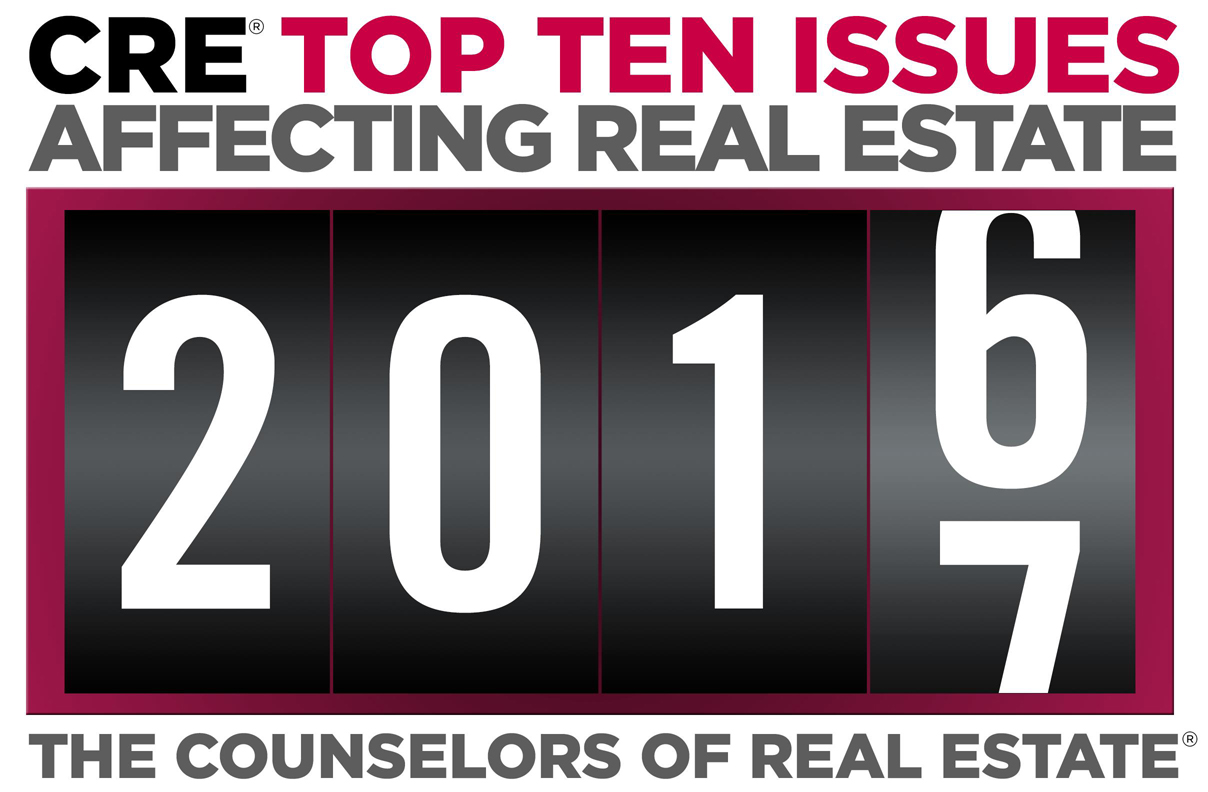
- The Changing Global Economy
GDP growth has been revised downward for much of the globe, as economic uncertainties continue. Currency issues and soft energy prices have added to volatility. Politics and conflict undermine stability, leading to the potential for deceleration, weakening exports and softening investment in real estate and other assets. The U.S. should remain highly attractive for global capital inflows-even if economies weaken further. - Debt Capital Market Retrenchment
Regulators are telling regional banks to pull back on commercial real estate lending; Basel III reserve requirements for construction and development loans rise to 150%; and CMBS issuance slows, as Dodd-Frank risk-retention rules go into effect in 2016. Insurance companies are approaching their allocation limits. The search for commercial real estate debt capital will become more intense, as will competition for capital. Tis presents risks for those seeking debt, and opportunities for alternative lenders, including crowd funding sources, and equity investors to enter the market. - Demographic Shifts
Millennials have overtaken the Baby Boomers in sheer numbers. Boomers are retiring at a rate of approximately 10,000 per day, and America’s population of persons aged 90-and-older is expected to increase to over 7.6 million over the next 40 years. Baby Boomers prefer to age in place, driving opportunities for medical, assisted living and memory care facilities. Look for a rise in renting over home ownership. Multi-family development remains strong. - Densification/Urbanization
Transportation options, walkability, extensive work/live/ play options favor close-in “urbanized” areas. Densification continues, as job growth and dynamic urban centers attract new residents and businesses. There is a growing trend in high density mixed-use centers. “Innovation centers” and “education centers,” in dynamic economies emerge, and cultural environments grow. Suburbs are becoming more “urban.” - The Political Environment
The U.S. elections are over, but the political environment remains acrimonious at all levels. Communities that demonstrate political stability and investment in infrastructure, transit, schools, etc., will attract residents, visitors and businesses. - Housing Affordability and Credit Constraints
The global housing market is at a critical juncture, as affordability and credit constraints challenge both owner and renter markets. Limited for-sale inventory and income stagnation are affecting affordability. Stringent credit requirements prevent many households from homeownership, increasing demand for rental property. The Counselors of Real Estate® annually releases the CRE® Top Then Issues Affecting Real Estate, sharing the most critical factors impacting real property. Multifamily development continues but rents outstrip incomes in many communities. Questions arise about housing newly formed households and the workforce. We expect strong demand for rental housing and a slowdown in rent growth. Single family builders are beginning to target “starter homes.” - The Disappearing Middle Class
Median middle-class household income fell five percent between 2000 and 2014, and median wealth has declined by 28 percent since the recession. Rising costs affect middle class families. Millennials are falling behind in assets and income. Stagnant purchasing power affects where people can live, driving a rise in high-density multi-family and affordable housing. Luxury development continues to do well. While middle-market retailers (e.g., Sears, Macy’s) contract, new opportunities rise (i.e., Wal-Mart and Dollar General at the low end of the spectrum vs. luxury retailers such as Nordstrom and Neiman Marcus). - Energy
Energy price instability threatens global economic security and US regional economies. Recently booming towns are busting, and a $ 2 trillion clean tech market is driving regional growth in other markets. A natural gas boom in the US, combined with a drastic reduction in renewables pricing, make it difficult for oil to compete– suggesting continuing dislocation in many markets regardless of political changes. - The Sharing/Virtual Economy
New enterprises, such as Airbnb, Uber and bicycle-sharing companies (e.g., Divvy) have become alternatives to traditional lodging and transportation, offering alternatives for employment. Shared office spaces are rapidly becoming more widespread; “virtual” offices offer office amenities to small businesses. Crowdfunding has become an alternative source of capital for new enterprises and investment, including real estate. These enterprises will continue to change the economy and their traditional counterparts. - The Rise of “Experiential” Retail
Retail is adapting, as stores close or downsize physical footprints, adding more online options. As retailers retrench and reimagine their models, online retailers thrive. Amazon is now the biggest retailer in terms of dollars. “Destination” retail development is emerging, with malls becoming “experiential” – providing services and “showroom” spaces, while actual purchases are made online, and are redefining the concept of ‘anchor’ stores. New retail concepts, including local and regional shops and fewer chains create new shopping experiences.
This article is from the National Association of REALTORS Commercial Connections Winter edition https://www.nar.realtor/articles/industry-trends-the-cre-top-ten-issues-affecting-real-estate-2016-2017